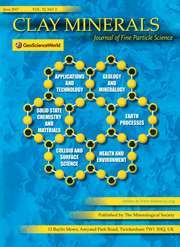Article contents
The removal of free iron oxide from clays*
Published online by Cambridge University Press: 14 March 2018
Extract
The techniques previously employed in this laboratory for removing free iron oxide from soil clays were the acid ammonium oxalate and the aluminium-ammonium tartrate methods (Tamm, 1922; Dion, 1944). Since both had disadvantages, especially when determining the iron by sodium salicylate (Scott, 1941), the use of sodium hydrosulphite, Na2S2O4, (Galabutskaya and Govorova, 1934; Deb, 1950) was fully investigated in the hope that it might lead to the development of a satisfactory, completely inorganic procedure.
- Type
- Research Article
- Information
- Copyright
- Copyright © The Mineralogical Society of Great Britain and Ireland 1954
Footnotes
This is a brief summary. For full details consult the papers of Mitchell and Mackenzie (1954) and Mackenzie (1954).
References
- 4
- Cited by


